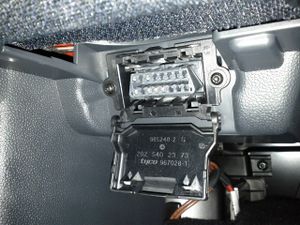Getting Started
These are the steps you will need to take when setting up the adapter for the first time. All of these following items can be done without the engine running on your vehicle, just the ignition turned to 'on'/'accessory'. Always make sure you are not putting yourself at risk when working on a vehicle.
A list of adapters that are known to work with Torque are available here
Don't forget the settings menus and vehicle profile menu that allow you to customise the app to your requirements - a video of how to navigate to the settings is here
Initial Setup
First, locate the vehicle diagnostics socket - it should be a similar shape that will let the adapter plug into it. Some common places for it are underneath the drivers-side dashboard, or behind a flap near or underneath the steering wheel. Some vauxhalls/GMs have them placed in the centre 'tunnel' between drivers and passenger seats underneath the ash tray, and Alfas could be in the passenger glovebox.
Once you have located the socket, plug the adapter into it. Some lights on it should light up. If you are using the PLX adapter, make sure it is turned on if it has a switch.
Now you need to pair the adapter with the phone. Some common pairing codes here are '0000' or '1234'. For older versions of Android (1.5 & 1.6), you may need to pair the phone 'twice'(check the notification bar for the pairing request after pairing for the first time).
Pairing the adapter with the phone is relatively simple:
- Go to the phones bluetooth settings, accessible via the phones 'Settings->Wireless and networks->Bluetooth settings'
- Scan for devices
- Wait until the bluetooth device shows in the list - it should say 'scantool','obdkey','plx ...','cbt' or something similar.
- Select the device, you will be asked for a pairing code, enter the pairing code for the device.
- You are now paired. If you are using Android 1.5 you may get asked a second time (in the notification bar) to authorise the pairing - use the same pin code here as well.
Selecting the adapter with Torque
- Launch Torque, and go into the applications settings menu
- Select the "OBD2 Bluetooth Settings" settings option
- Scroll down the list of items until you see 'Connection Type' in the list. Make sure this is set to 'Bluetooth'
- Scroll down to the bluetooth preferences section, select 'Choose Bluetooth Device' and select the adapter you paired with earlier.
- Torque is now setup, and should connect to the adapter. To speed things up you might want to quit the app and restart it
Make sure your vehicle ignition is on (the engine does not have to be running) and Torque will start to read sensor information from the ECU. When Torque is properly connected, all the flashing icons at the top right of the main screen should turn blue and stay solid.
Further Help
Please note that your vehicle must be OBD2 compatible for the app to work, if the vehicle is not OBD2 compatible then the adapter will not be able to establish a connection to the ECU. (just having the correct shaped connector does not automatically mean your vehicle is OBD2 compliant) Some clone adapters also have trouble connecting to the ECU due to various bugs (mostly on the Ford J1850PWM protocol) so you may need to check the adapter is also working correctly if it is a clone. As a rough guide, petrol/gasoline vehicle build from 1996 onwards should be OBD2 compliant and Diesels from 2004 onwards (though some manufacturers like VW implemented this standard as early as 2001 for some diesels). Torque should work with *any* OBD2 compliant vehicle!
The main wiki page is here and there are forums where you can register and chat about the app here
